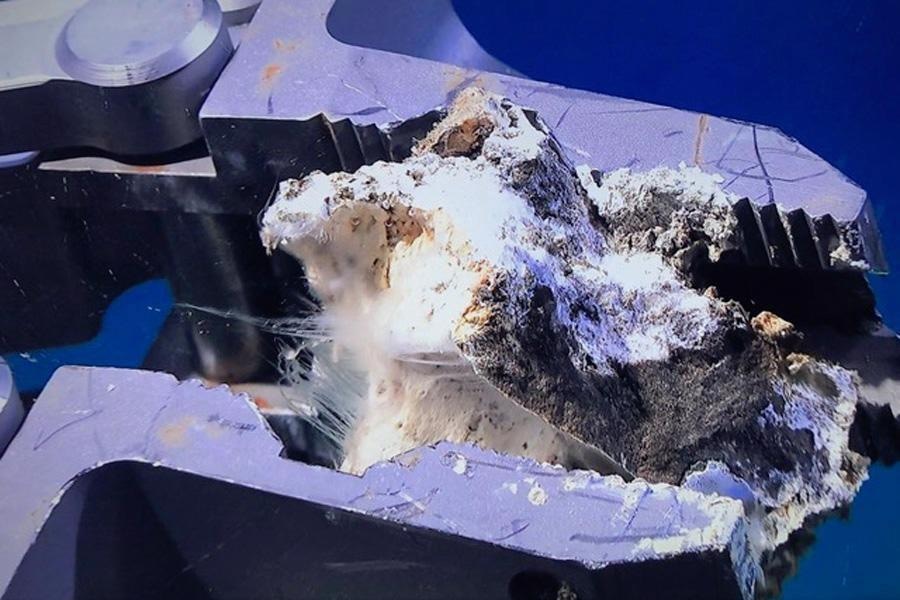Apr 13 2021
A team of researchers from the University of Minnesota has found that deep-sea bacteria dissolve carbon-containing rocks and discharge surplus carbon into the air and ocean.
 CSE researchers collected samples of carbonate rocks from the Del Mar East methane seep using a submersible watercraft. They discovered that deep-sea bacteria are dissolving these rocks, releasing excess carbon into the ocean and atmosphere. Image Credit: Leprich, et al., Bailey Geobiology Research Group, University of Minnesota.
CSE researchers collected samples of carbonate rocks from the Del Mar East methane seep using a submersible watercraft. They discovered that deep-sea bacteria are dissolving these rocks, releasing excess carbon into the ocean and atmosphere. Image Credit: Leprich, et al., Bailey Geobiology Research Group, University of Minnesota.
The study results will enable researchers to better evaluate the amount of carbon dioxide in Earth’s atmosphere, which is a principal driver of global warming.
The study has been published in The ISME Journal: Multidisciplinary Journal of Microbial Ecology, a peer-reviewed scientific journal part of the Nature family of publications and the official journal of the International Society for Microbial Ecology (ISME).
If CO2 is being released into the ocean, it’s also being released into the atmosphere, because they’re constantly interchanging gases between them. While it’s not as big of an impact as what humans are doing to the environment, it is a flux of CO2 into the atmosphere that we didn’t know about. These numbers should help us home in on that global carbon budget.
Dalton Leprich, Study First Author and PhD Student, Department of Earth and Environmental Sciences, University of Minnesota
The scientists started investigating sulfur-oxidizing bacteria—a class of microbes that make use of sulfur as an energy source—in methane seeps on the ocean floor.
Similar to deep-sea coral reefs, such 'seeps' hold assortments of limestone that capture huge amounts of carbon. The sulfur-oxidizing microbes survive on top of such rocks.
The researchers observed patterns of holes and corrosion in the limestone and discovered that during sulfur oxidization, the bacteria make an acidic reaction that tends to dissolve the rocks. Then, this leads to the discharge of carbon trapped within the limestone.
You can think of this like getting cavities on your teeth. Your tooth is a mineral. There are bacteria that live on your teeth, and your dentist will typically tell you that sugars are bad for your teeth. Microbes are taking those sugars and fermenting them, and that fermentation process is creating acid, and that will dissolve away at your teeth. It’s a similar process to what’s happening with these rocks.
Dalton Leprich, Study First Author and PhD Student, Department of Earth and Environmental Sciences, University of Minnesota
The next step for the team would be to investigate this impact on various types of minerals. Going forward, such findings could also help researchers make use of dissolution features, such as crevices, holes, or other evidence that bacteria have dissolved rocks, to find evidence of life on other planets like Mars.
These findings are but one of the many examples of the important and understudied role that microbes play in mediating the cycling of elements on our planet.
Jake Bailey, Study Corresponding Author and Associate Professor, Department of Earth and Environmental Sciences, University of Minnesota
Besides Bailey and Leprich, other members of the research group are research associate Beverly Flood and former researcher Elizabeth Ricci from the University of Minnesota’s Department of Earth and Environmental Sciences, Assistant Professor Jeffery Marlow and PhD student Peter Schroedl from Boston University, and Harvard University Professor Peter Girguis.
This study was financially supported by grants from the National Science Foundation and NASA, which include a NASA Exobiology grant.
Journal Reference:
Leprich, D. J., et al. (2021) Sulfur bacteria promote dissolution of authigenic carbonates at marine methane seeps. The ISME Journal. doi.org/10.1038/s41396-021-00903-3.